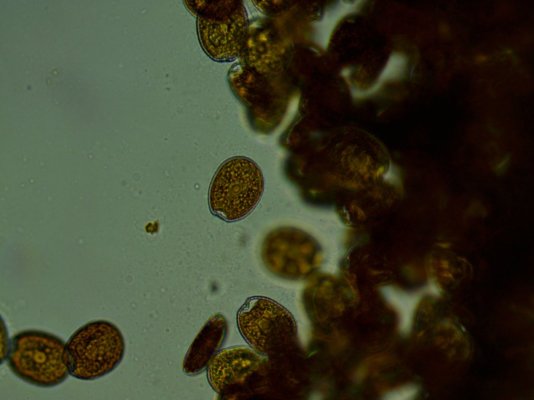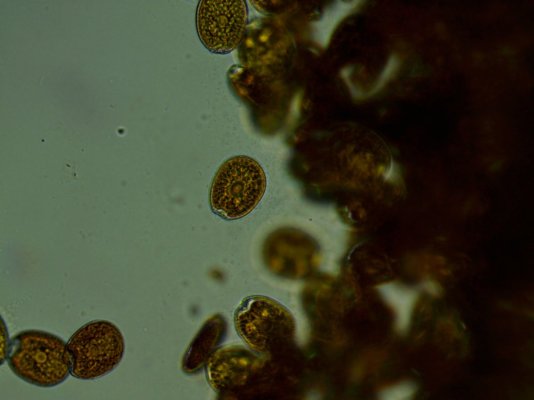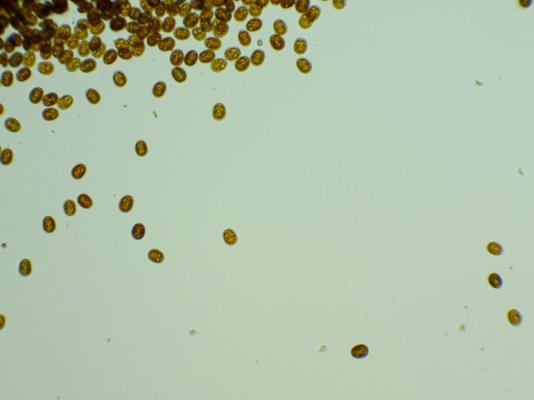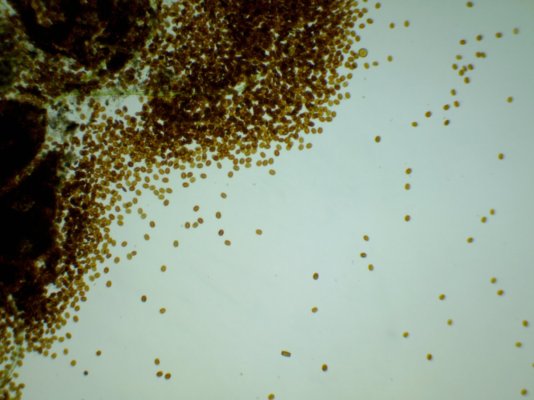Put a wooden air stone at your intake pump so it saturates the entire tanks water, It's more effective then just placing it in the tank. And yes 1ml per 10gallons of water. You'll see how it actually cleans the rock and everything else. When bubbling and the dinos leave the sand bed they attach to the fine bubbles and help remove them. You can also dose the peroxide directly into the skimmers air intake and watch how well the skimmer removes the crud from the water. It's going to supercharge the skimmers effectiveness a lot.That’s the thing, I really don’t have any strongly slimy stuff. Strictly tons of “dusting”. So you just put an air stone in your tank at night? 1 ML of peroxide per 10G when lights out, is that the ratio you used?
Navigation
Install the app
How to install the app on iOS
Follow along with the video below to see how to install our site as a web app on your home screen.
Note: This feature may not be available in some browsers.
More options
You are using an out of date browser. It may not display this or other websites correctly.
You should upgrade or use an alternative browser.
You should upgrade or use an alternative browser.
Dinoflagellates – Are You Tired Of Battling Altogether?
- Thread starter mcarroll
- Start date
- Tagged users None
Let’s see if this works. I put my white lab coat on, I grabbed sand that is in question and I stirred it up. James Cameron I am not…
I think Mr. Cameron's day job is safe, lol.
Large Cell Amphidinium and some competing diatoms. My suggestions on treatment are here:
A Dinoflagellate Treatment Guide
As the title suggests, this is intended as a short guide on what to do when you suspect dinoflagellates are trying to overtake your system. It is an attempt to boil down the protocols discussed across 11,000 posts in this "Are you Tired" thread...
 www.reef2reef.com
www.reef2reef.com
- Joined
- Feb 24, 2017
- Messages
- 335
- Reaction score
- 163
Has Silicate dosing been proven to beat dino's? I've removed 90% of my sand bed and almost all the dino's are gone for the exception of a small few where small amounts of sand remain. Just want some proven method to completely eradicate the rest. thanks.Yes, that's also Prorocentrum. I know many recommend UV for these but I don't find it helpful. I treat these just like LCA/SCA with silicate dosing as well as trying to increase biodiversity any way I can.
Silicate is just another tool to enhance the well being of OTHER surface competitors -- diatoms primarily.Has Silicate dosing been proven to beat dino's? I've removed 90% of my sand bed and almost all the dino's are gone for the exception of a small few where small amounts of sand remain. Just want some proven method to completely eradicate the rest. thanks.
The goal should not be complete eradication IMO. They are a naturally occurring micro organism in a stable biome. We all have some given enough time. In a stable biome with lots of healthy surface competitors (film algae, bacterial film, coralline, cyano, diatoms + dozens more) dinos live a very marginal existence.
I have had no visible dinos in my system for years, but if I swabbed enough surfaces and looked through the scope I know I would find some.
Been just over two weeks in to my infestation, I noticed early and removed most of my chaeto and dosed nitrates(dang chaeto ate everything). The tank has been blacked out for a week now and I'm also dosing microbacter daily(10ml) alongside spongexcel silicates. I also just installed a green killing machine sterilizer to take out anyone that's been blown into suspension. The stuff has receeded after blacking out, although it seems to return after a day or two of normal light schedule.
ID haven't returned anything conclusive, which is extremely odd. I gave one of my friends some sludge from my sump which is even more heavily populated with dinos than my display, but the microscope showed literally nothing alive in there apart from a single diatom and some dead dino scraps.
ID haven't returned anything conclusive, which is extremely odd. I gave one of my friends some sludge from my sump which is even more heavily populated with dinos than my display, but the microscope showed literally nothing alive in there apart from a single diatom and some dead dino scraps.
"sludge" well now that might be something else. Chrysophytes perhaps. Check out this old post of mine. Does it kinda retain it's gelatinous form when removed from the water?Been just over two weeks in to my infestation, I noticed early and removed most of my chaeto and dosed nitrates(dang chaeto ate everything). The tank has been blacked out for a week now and I'm also dosing microbacter daily(10ml) alongside spongexcel silicates. I also just installed a green killing machine sterilizer to take out anyone that's been blown into suspension. The stuff has receeded after blacking out, although it seems to return after a day or two of normal light schedule.
ID haven't returned anything conclusive, which is extremely odd. I gave one of my friends some sludge from my sump which is even more heavily populated with dinos than my display, but the microscope showed literally nothing alive in there apart from a single diatom and some dead dino scraps.

Symbiodinium. Got any treatment ideas?
While it looks kinda similar to ostreopsis in the tank, it is very different under the scope. They are VERY small and completely motionless. They are easily basted or siphoned away but return the next day. They don't stick to coral flesh, but do stick to everything else. I FEEL like they are...
 www.reef2reef.com
www.reef2reef.com
Now that it's mostly gone, I can't remember what it looked like. In certain spots it did look like this and it certainly gunked up all my turf and hair algae. When I blast the stuff off the rocks and turn off the flow, it becomes thin verticle lines suspended in the water column that disperse with disturbance. The growth rate seemed too fast for sessile algae though, that stuff at its peak was returning every few hours after I blasted them off. Blacking out seems to kill them much faster than it kills off my corals."sludge" well now that might be something else. Chrysophytes perhaps. Check out this old post of mine. Does it kinda retain it's gelatinous form when removed from the water?

Symbiodinium. Got any treatment ideas?
While it looks kinda similar to ostreopsis in the tank, it is very different under the scope. They are VERY small and completely motionless. They are easily basted or siphoned away but return the next day. They don't stick to coral flesh, but do stick to everything else. I FEEL like they are...www.reef2reef.com
It does not remain gelatinous out of water... in fact, it's kinda impossible to get it out of the water in the first place. Scatters like a powder, which seems more like dino behaviour.
Good post I had a bad case of dinos for a little while maybe 2 years or so. The cheato thing may have had some to do with it for sure. Started with dry rock and started my fudge as soon as nitrates went up. I bought a uv but never installed it. Tried many things before they went away.I don't know what percentage of folks had luck battling dinos with any of the methods in the old Dino thread but it's obviously a very low percentage, so I'd like refresh folks on the natural alternatives and lay out three areas of info:
Let's get started!
- some of the factors that contribute to a dino outbreak
- how to avoid common dino outbreaks
- and what do if your tank is already having an outbreak
Common Contributing Factors
Some of the most common factors that contribute to the dino outbreaks we cover in this thread are:
These four factors, or excess nutrient removal generally, play – usually in combination; rarely just one factor alone – pretty directly into dino's conversion to the blooming, phagotrophic, mat forming, toxin-producing side of their nature.
- the tank being new, rock being immature or the tank being otherwise highly disturbed, such as by other harsh tank treatments
- hard core nutrient reduction tools being used, such as
- organic carbon dosing
- excess "bio media"
- algae filtration
- nutrient adsorbing media like GFO
How To Avoid Having A Dino Outbreak
- Starvation Is Their Cue
- Dino's seem to prefer life as autotrophic epiphytes on macro algae – chaeto morpha seems to be one of their favorite types to host in. (Maybe this fact can be useful to us; maybe sometimes chaeto ought not be used, or used with special consideration)
- For several reasons, dino's seem to be terrible at nutrient uptake. This means they are more prone to starvation than many or most other microorganisms they have to compete with.....especially bacteria, which can scavenge free nutrients down to CRAZY low levels...low enough to starve out other microbes or algae.
- With their protective mucus mats, potential to generate wicked toxins, and ability to survive not only by way of photosynthesis and dissolved nutrients, but alternately, when times get tough, by "eating their neighbors". (The least of their tricks.)
- Dino's generally gain a competitive edge against their competitors AND their predators in a nutrient-starved environment. Keep reading!
In a nutshell, here's how to avoid dino outbreaks and begin to normalize your tank if you already have an outbreak:
What to do if you're tank is already having a dino outbreak
- Phosphate Control
- DO NOT let your phosphates hit or stay at zero.
- See: Bacterivory in algae: A survival strategy during nutrient limitation
- Nitrate Control
- Do not let your nitrates hit or stay at zero.
- See: Putting the N in dinoflagellates
- See: A Nitrate Dosing Calculator For Better Tank Health (And Better Coral Color!)
- Starvation conditions (zero or near-zero nitrate or phosphate levels) should be avoided.
- Keep in mind that dissolved nutrients are not "waste products" to be eliminated
- They are nutrients for the critters you care about like corals
- The are also nutrients for a potential multitude of mostly-unknown/anonymous microbes that are needed to bring stability to a new tank.
- Once excess nutrients have an impact, in fact, they usually can't be simply eliminated with media anyway – they've probably already had an impact on the tank's microbial cycle. (See blog link #3 at bottom.)
- This all adds up to skipping almost all "extra" nutrient removing steps during the tank's initial development. This period seems to be especially critical, and longer in a tank started with dry, dead rock. Don't use anything until it's absolutely needed and other options have been fully exhausted...and be conservative with how you apply any nutrient removing tool.
When attempting to control an organism like a dinoflagellate, confirming the ID will help, if possible:
- So to begin with, make sure you have Dinos – you should have multiple factors at work...these factors were mentioned in the first section above. The less these factors seem to describe your tank, the less likely any of this advice will be correct for your situation – so post questions!
- Once you have confirmed that you have dino's you should ideally figure out what type(s) your tank is hosting. (Multiple species blooms seem almost as common as single-strain blooms.)
- A basic 1200x microscope will be useful and doesn't have to be fancier than a $15 toy scope. Even a $50 scope is a lot nicer, if you think you might be more serious about it.
- See: Selecting a microscope for more discussion.
- Compare your dino's with photos where @taricha and @Beardo have already made ID's:
- (Click the link. Then click the SEARCHbutton at the bottom of the search page.)
- ostreopsis
- prorocentrum
- amphidinium
- Amphidinium Dinoflagellate Treatment Methods (they are unique and somewhat more experimental)
- coolia
- (other searches coming)
So, after you get a measure of control, make sure you read What is the End Game?
- Extra Measures
Generally, these tools will give extra control in terms of removing and/or killing cells in the water column....usually, along with other measures explained here, expediting the close of the dino bloom.
- UV
You can find discussions throughout the thread by using this search, with a great breakout of spec's on post #3770.- Diatom Filtration
Effective, but not that popular. The more common units like the classic Vortex are somewhat difficult to use, and the newer units like the new Marineland Polishing Filter are relatively unknown. Still worthy of consideration.
Miscellaneous Goodies
- Post #2725 has a great diary of tank observations, test results and time-series graphs during the treatment for dino's from one of our members.
- Disturbances we cause in our tanksare what allow microbial/algal populations to shift and ugly/harmful blooms to happen.
- Take measures to assure that your feeding system is very consistent. An auto-feeder is an overlooked tool on most tanks. Look at Eheim's feeders...set them on low with high quality flake food. Just don't let them run your whole feeding program as flake isn't great food.
- Find out what inconsistencies you can eliminate with your husbandry to prevent more unneeded disturbances and the resulting microbial/algal changes. This could be changes to lighting or water chemistry – make them as consistent as you can.
- E.g. If you're adding new livestock all the time, stop it. If you have a color-tunable light fixture, stop re-tuning the colors. If you don't have an ATO keeping your salinity stable, get one. If you're still managing your dosing by hand, get an $80 4-head doser. Etc.
- If you provide the stability, then your dino's competitors will start competing with them and their predators will start eating them!!
- One thing that seems to help things progress is to stop scraping down the algae off your glass....once the dino's start giving up space that is. Mechanical removal is a legit short-term strategy and might help give competitors a leg up too.
2¢
Other interesting more-or-less related links on my blog:
(Also cross-posted in the old Dino thread!)
- The role of nutrients in decomposition of a thecate dinoflagellate
- Effects of organic carbon, organic nitrogen, inorganic nutrients, and iron additions on the growth of phytoplankton and bacteria during a brown tide bloom
- Response of heterotrophic bacteria, autotrophic picoplankton and heterotrophic nanoflagellates to re-oligotrophication
Wow, all my years of perusing this thread and I never came across this very helpful post. Thanks for sharing. Heck, I probably wouldn't have written this article that was designed to synthesize this whole thread.Good post I had a bad case of dinos for a little while maybe 2 years or so. The cheato thing may have had some to do with it for sure. Started with dry rock and started my fudge as soon as nitrates went up. I bought a uv but never installed it. Tried many things before they went away.
A Dinoflagellate Treatment Guide
As the title suggests, this is intended as a short guide on what to do when you suspect dinoflagellates are trying to overtake your system. It is an attempt to boil down the protocols discussed across 11,000 posts in this "Are you Tired" thread...
 www.reef2reef.com
www.reef2reef.com
I could use a hand diagnosing what I think are dinos. I've had what I thought was red cyano growing on my sandbed for a year now. It's a heavier mat that is very difficult to suction, in fact it's easier to remove the sand then the goo. It primarely grows on the sandbed but I also have it on the rocks in smaller amounts. I've dosed Chemiclean several times and though it seems to get knocked back, it never goes away more than 5
0% and then quickly returns as soon as I remove the Chemiclean.
The picture was taken at 40x and the video at 10x.
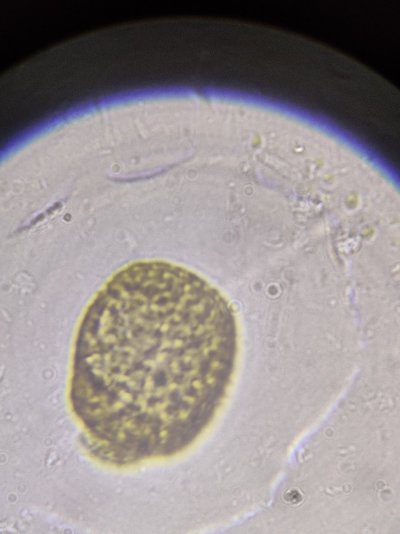
0% and then quickly returns as soon as I remove the Chemiclean.
The picture was taken at 40x and the video at 10x.

The crooked beak is the tell -- Large Cell Amphidinium.I could use a hand diagnosing what I think are dinos. I've had what I thought was red cyano growing on my sandbed for a year now. It's a heavier mat that is very difficult to suction, in fact it's easier to remove the sand then the goo. It primarely grows on the sandbed but I also have it on the rocks in smaller amounts. I've dosed Chemiclean several times and though it seems to get knocked back, it never goes away more than 5
0% and then quickly returns as soon as I remove the Chemiclean.
The picture was taken at 40x and the video at 10x.

Yes, that is my guess. Maybe @taricha can confirm.Would this be Amphidinium (Small Cell) . Only suggesting it due to thete fast swimming pattern
Not sure if these pictures and video are good enough for ID.
Just this week, my sandbed is getting a lot of reddish gunk but doesn't look slimy.
*had Ostreopsis earlier this year and UV cleared that up at the time -- this obviously moves differently
Odd note (to me) -- most of the cells don't seem to move at all, only very few.
*this is sucked out right from the tank and immediately put onto single surface under microscope


Just this week, my sandbed is getting a lot of reddish gunk but doesn't look slimy.
*had Ostreopsis earlier this year and UV cleared that up at the time -- this obviously moves differently
Odd note (to me) -- most of the cells don't seem to move at all, only very few.
*this is sucked out right from the tank and immediately put onto single surface under microscope
- Joined
- May 22, 2016
- Messages
- 6,594
- Reaction score
- 10,183
Unsure, but lean toward coolia.Not sure if these pictures and video are good enough for ID.
Can anyone help me out?I have been battling these for months now. Can someone please help me identify them?
Thanks,
Thanks
Silicate dosing reality check:
I was planning to dose +2 ppm WEEKLY to promote diatoms and likely scale back from there but I see some posts in this thread suggesting that much DAILY.
Isn't that risky?
For reference, I'm using Loudwolf 41% sodium silicate so 0.4 mL should be enough for roughly +2 ppm in 30 gallon water volume based on reading and scaling from what others have calculated.
I was planning to dose +2 ppm WEEKLY to promote diatoms and likely scale back from there but I see some posts in this thread suggesting that much DAILY.
Isn't that risky?
For reference, I'm using Loudwolf 41% sodium silicate so 0.4 mL should be enough for roughly +2 ppm in 30 gallon water volume based on reading and scaling from what others have calculated.
Can i get an ID please? If this is even anything... first time trying to use a microscope and its just my kids'. 
Similar threads
- Replies
- 4
- Views
- 168
- Replies
- 3
- Views
- 174
- Replies
- 2
- Views
- 592
- Replies
- 2
- Views
- 396









